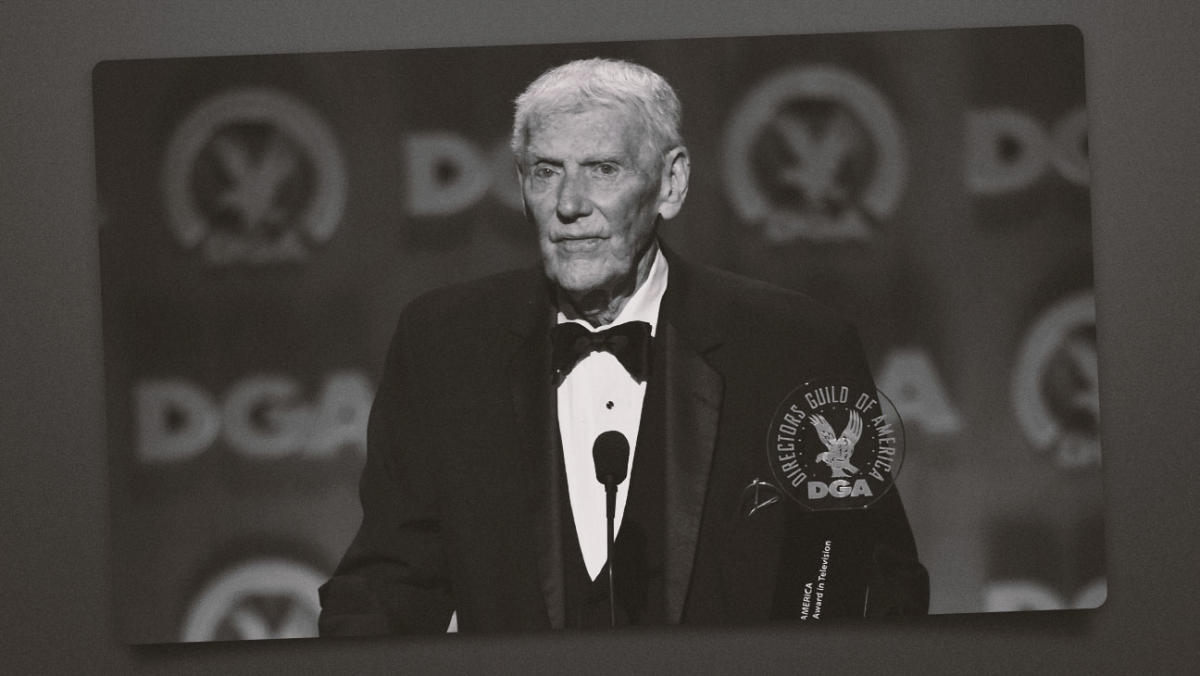Robert Butler, the Emmy-winning, go-to pilot director who helmed the first episodes of such acclaimed shows as Batman, Star Trek, Hill Street Blues and Moonlighting, died Nov. 3 in Los Angeles, his family announced. He was 95.
Butler also co-created the Pierce Brosnan-starring Remington Steele (and helmed its pilot, of course), directed the first episode of Hogan’s Heroes in 1965, and called the first shots and set the tone for, Glenn Gordon Caron’s Moonlighting, Lois and Clark: The New Adventures of Superman, Sisters and The Division.
More from The Hollywood Reporter
In 1973, he directed the William Holden-starring The Blue Knight — the first four-hour television miniseries — at NBC and then got the CBS series adaptation of the Joseph Wambaugh novel that starred George Kennedy off on the right foot.
Butler also helmed two episodes of The Twilight Zone (the fifth-season installments “Caesar and Me,” starring his old friend, Jackie Cooper, and “The Encounter”) and worked on The Dick Van Dyke Show, The Untouchables, Dr. Kildare, The Fugitive, Walt Disney’s Wonderful World of Color, Gunsmoke, Hawaii Five-O, Kung Fu, I Spy, Columbo, The Waltons and Ironside.
He received the DGA’s inaugural Lifetime Achievement Award in Television Direction in 2015, being honored alongside James Burrows, the king of the sitcom pilot. Fourteen years earlier, he was presented with the Robert B. Aldrich Achievement Award in recognition of his decades of service to the guild.
Butler was pals with screenwriter Lorenzo Semple Jr., who developed Batman for ABC, as their wives had known each other since they were kids. So Semple was delighted when producer William Dozier hired his friend to bring the Caped Crusader from the comic books to life in late 1965.
“Dozier knew me when he was a CBS boss [and] I was a very efficient associate director,” Butler said in the 2016 book Batman: A Celebration of the Classic TV Series, written by Bob Garcia and Joe Desris. “He knew me as a guy who knew production and would get the job done right.”
Butler took 21 days to film the highly touted pilot episode of Batman (split into two half-hour installments that aired on Jan. 12 and 13, 1966), which featured Frank Gorshin as The Riddler. He employed hand-held cameras and “Dutch angle” shots that showed the villains in “slanted” environments (they were crooked, after all).
Butler then helmed another pair of two-parters in the Adam West-starring series’ first season, ones that featured The Penguin (Burgess Meredith) and Mister Freeze (George Sanders).
Butler had directed two episodes of Gene Roddenberry’s The Lieutenant military drama in 1963-64, and the writer-producer asked him to tackle “The Cage,” the original pilot episode for Star Trek, in 1966. It starred Jeffrey Hunter as the ship’s captain alongside Leonard Nimoy as Mr. Spock.
“I read the script and said, ‘This is just a palette of science fiction,’ ” he recalled in a 2004 interview for the Archive of American Television. “I remember talking to my wife about it and saying, ‘This is too nuts, I don’t know whether to do this.’ She said, ‘Ah, why don’t you do it?’ So I did.
“NBC saw the show and said, ‘We like it, we want it, we don’t understand it, do it again.’” So another pilot was ordered, and William Shatner was in for Hunter. “The Cage” wasn’t broadcast in its entirety until 1986, though some of Butler’s footage was used in the first-season two-parter “The Menagerie.”
For the pilot of Hill Street Blues, the landmark Steven Bochco-Michael Kozoll cop show that aired on NBC from 1981-87, Butler said he wanted it to look “messy.”
“In my mind, the show came from the congestion of the material, the congestion of the characters,” Butler said in a 2011 story about the cop drama that was published on the DGA website. “I remember the camera operator cleaning up shots, in the classic Hollywood style that I had begun to hate, and I had to brainwash him to let it be a mess.
“The trick was to make it look seemingly real, live, raunchy, congested. We jammed the streets with derelict cars and graffiti. We suggested Eastern-city crunch very well.”
Michael Zinberg, then NBC’s vp development at the time, said the pilot “was the single most compelling screening I’ve ever seen. It killed the room. As good a script as it was, it wasn’t until Bob Butler put his hands on it that it became Hill Street Blues. He was an adventurous thinker and took everything that had been done before and launched it into a whole new level. Hire any other director, and you don’t get that show.”
Butler won an Emmy for directing the pilot episode after receiving two trophies for the Blue Knight miniseries. He was nominated seven times in all, including twice for the pilot for ABC’s Moonlighting, the 1985-89 comedy-drama that starred Cybill Shepherd and Bruce Willis as private detectives.
In the Batman book, he said working on the first episodes had a distinct advantage.
“On pilots, everyone is hungry. Everyone is paying attention,” he said. “There is less goofing around. They want to sell it. They want to get it on the air. [Everyone has the attitude of,] ‘How can I help? What can I do?’”
Robert Stanton Butler was born on Nov. 16, 1927, in a hospital in Hollywood. His father was an insurance adjuster and his mother a schoolteacher. He grew up on the Westside and attended University High School. He played the trombone, and as a teenager, he was a musician in the band on Hoagy Carmichael’s live NBC Radio variety show.
After graduating with a degree in English from UCLA, Butler landed a job as an usher at CBS in Hollywood and quickly rose through the ranks to receptionist, production clerk, stage manager and then assistant director on such live anthology shows as Climax! and Playhouse 90.
Butler got his first shot at directing on a 1959 episode of the TV comedy Hennesey, which starred Cooper as a Navy doctor, then went on to such shows as The Many Loves of Dobie Gillis, The DuPont Show With June Allyson and Have Gun — Will Travel.
After Cooper turned down an offer to direct the Hill Street Blues pilot, MTM Enterprises president Grant Tinker went after Butler.
Butler came up with the concept for the Brosnan show: A woman (Stephanie Zimbalist) wants to run a detective agency but has to invent a fictitious male superior, named Remington Steele, to get nervous clients comfortable enough so they’ll sign on.
Butler originally had Steele as nothing more than innuendo, but writer Michael Gleason thought the character should come to life, and that’s how it would be when the series bowed on NBC in 1982.
Butler also helmed a few features, including The Computer Wore Tennis Shoes (1969), The Barefoot Executive (1971) — both at Disney — and Turbulence (1997).
“Few directors have changed the face of television as much as Bob did — his impact on the medium is truly immeasurable, and this loss to our guild is deeply felt,” DGA president Lesli Linka Glatter said in a statement.
“At ease in any genre, Bob’s pilots established the look and feel of several seminal series including Hogan’s Heroes, Batman and Star Trek. His groundbreaking work on Hill Street Blues brought to life the grit and reality of an urban precinct by coupling his unique visual style with evocative performances he coaxed from an incomparable cast, forever changing the trajectory and style of episodic procedurals.”
Survivors include his wife, Adri; children Robert Jr. and Cornelia; and grandsons Rainer and Liam. Gifts in his honor may be made to the Directors Guild Foundation, for whom he was a trustee for more than 35 years. He joined the DGA in 1959.
Best of The Hollywood Reporter

Laura Davis is an entertainment aficionado who delves into the glitz and glamour of the entertainment industry. From Hollywood to Broadway, she offers readers an insider’s perspective on the world of movies, music, and pop culture.






